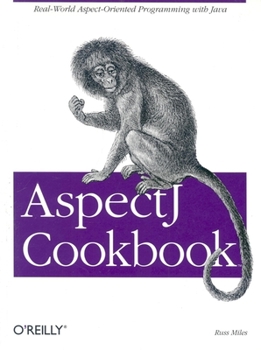Aspectj Cookbook
Select Format
Select Condition 
Book Overview
When Object Oriented programming (OO) first appeared, it was a revelation. OO gave developers the ability to create software that was more flexible and robust, but as time went on and applications became more sophisticated, too, certain areas of "traditional" OO architectures were found wanting. Aspect-oriented programming (AOP) addresses those issues by extending the OO approach even further. Many developers are interested in AOP--especially in AspectJ,...
Format:Paperback
Language:English
ISBN:0596006543
ISBN13:9780596006549
Release Date:January 2005
Publisher:O'Reilly Media
Length:331 Pages
Weight:1.35 lbs.
Dimensions:0.8" x 7.1" x 9.4"
Customer Reviews
3 ratings
teaches how to use, but look elsewhere for why
Published by Thriftbooks.com User , 19 years ago
You need to already know the ideas behind aspect orient programming [AOP}, before opening this book. Plus a fluency in Java, by the way. While I have the latter fluency, I'd only met AOP briefly in a few papers. Under the familiar O'Reilly cookbook format, the book has guidelines on various difficulties you might be having, when running AspectJ. It's a superset of Java. The new syntax is not so difficult to learn. True, it's more involved than writing a new class, that conforms to existing Java syntax. But a good Java programmer should quickly grasp how to implement crosscuts or advice. As to the broader issue of whether you should use AOP at all, the book is silent. It tells you well how to use AOP in the form of AspectJ. But you need to decide, based on externalities, whether to take it up at all.
Comprehensive and practical
Published by Thriftbooks.com User , 19 years ago
Because of AspectJ's complex syntax it really benefits from a cookbook-style approach. I find the abstract concepts of AOP are somtimes a lot easier to understand than the AspectJ syntax (involving aspects, pointcuts and advice) needed to implement them. Russell Miles has done a great job of structuring the book in a logical way. The book begins with recipes for compilation and deployment of Aspectj code using all the usual tools. The second section explains how to capture join-points on all the event types supported by AspectJ, ie. method-calls, exception catch blocks, object initialization etc. These first two sections form a good starting point reference for AspectJ syntax. The bulk of the rest of the book contains recipes for practical use of aspects. I'm no expert on the topic but these chapters struck me as quite a good selection of the 'cross-cutting' concerns that people usually bring up in AOP discussions. eg. language extensions, object persistence, logging and tracing, virtual mock objects, RMI, lazy loading, transaction handling, security policies etc. The author also includes recipes for using Aspects to implement each of the GoF patterns. I found some of these recipes more interesting than practical - the benefits of using aspects seemed tenous in some cases (do all of them really involve cross-cutting concerns?) although they widened my view of the potential applications of AOP. I generally found the recipes very well written and clear. The book also includes many UML sequence diagrams that are great for showing how aspects get woven in. I think AspectJ really needed a book like this - all in all a great contibution to the O'Reilly series.
Excellent programmers' hand book for AspectJ
Published by Thriftbooks.com User , 19 years ago
This is an excellent practical guide to incorporating Aspects, in particular AspectJ, into your object-oriented software skillset. This book is not a theoretical study of AOP; rather, it is a guide book for the software engineer who has already decided that using Aspects will benefit his or her software and is now looking for a 'How-To'. As a handbook, it begins with how to install AspectJ; how to build projects with Eclipse and Ant; and also looks at how to deploy AO applications, web applications and web services. It then goes on to look at basic and advanced AspectJ features and usage. As a side note, the Eclipse IDE provides great visual AspectJ support and is worth having a look at if you are planning on using AspectJ ;) This is a book that a software developer can dip into when programming using Aspects - to find out how to do something; or using the design pattern chapters - how to do it better.






